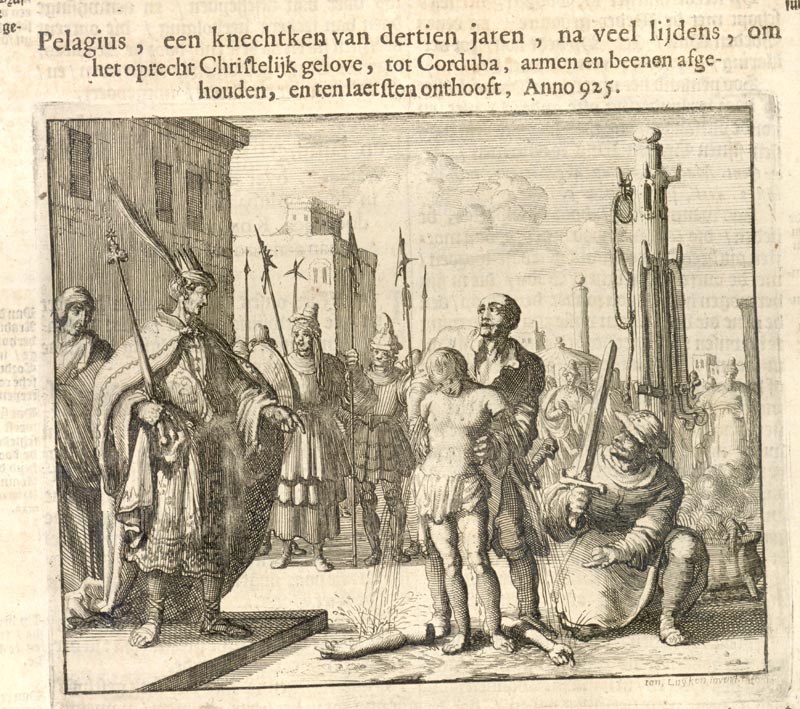- Pelagius of Cordova
Infobox Saint
name=Pelagius of Cordova
birth_date=c. 912
death_date=926
feast_day=June 26
venerated_in=
imagesize=300px
caption=The martyrdom of Saint Pelagius of Cordova
birth_place=Asturias , Spain
death_place=Cordova
titles=Martyr
beatified_date=
beatified_place=
beatified_by=
canonized_date=
canonized_place=
canonized_by=
attributes=
patronage=abandoned people, torture victims, Castro Urdiales, Spain
major_shrine=Oviedo
suppressed_date=
issues=
prayer=
prayer_attrib=Saint Pelagius of Cordova (c. 912–926) is said to have been a Christian boy left by his uncle at the age of ten as a hostage with the
Caliph Abd-ar-Rahman III ofal-Andalus , in trade for a clerical relative previously captured by theMoors , the bishopHermoygius . Pelagius was intended to be eventually released in an exchange of hostages.The exchange never occurred and Pelagius remained a captive for three years. The modern version of the story is that according to the testimony of other prisoners, his courage and faith was such that the Caliph was impressed with him when he had attained the age of thirteen. The Caliph offered him his freedom if Pelagius converted to
Islam . The boy, having remained a pious Christian, refused the Caliph's offer.The original version of the story took into account the beauty of the boy and the desire of the caliph. This construct "served an obvious polemical purpose for European Christians in their demonizing of the Muslims, who are pictured as prone to same-sex desire." At the same time, the flattery of his beauty by early Christian choirs suggests an awareness on the part of the Christians themselves of the dangers of such attractions, [ [http://findarticles.com/p/articles/mi_m2096/is_n2_v48/ai_20968469 The Invention of Sodomy in Christian Theology. - book reviews | Cross Currents | Find Articles at BNET.com ] ] and has prompted modern observers to remark that "That liturgy [...] focuses as intently on Pelagius's beauty as did the caliph." ["Ganymede/Son of Getron: Medieval Monasticism and the Drama of Same-Sex Desire" by V. A. Kolve in "Speculum," Vol. 73, No. 4 (Oct., 1998), pp. 1014-1067]
In the eroticized version of the story, his beauty was such that the Caliph fell in love with him when he had attained the age of thirteen. The boy, having remained a pious Christian, refused the Caliph's advances, striking the monarch and insulting him. Enraged, Abd-ar-Rahman had the boy tortured (which he survived for six hours) and dismembered. [Mark D. Jordan, "The Invention of Sodomy in Christian Theology," Chicago, 1997; pp. 10-28] Other accounts have him flung from a parapet after stripping himself naked, although these alternative accounts uphold his refusal to fulfill the Caliph's wishes. [ Sarah Salih: "Versions of Virginity in Late Medieval Europe:" Woodbridge: DS Brewer: 2002; ]
Pelagius was later enshrined as a Christian
martyr andcanonized as "Saint Pelagius." His observation is celebrated onJune 26 . [http://www.op.org/domcentral/life/martyr06.htm The Martyrology of the Sacred Order of Friars Preachers] The cult of Saint Pelagius is thought to have provided spiritual energy for centuries to the IberianReconquista , and is seen by some modern scholars as part of a pattern of portraying Islamic morality as inferior to other moral theories. [Walter Andrews and Mehmet Kalpaklı, "The Age of Beloveds," Duke University Press, 2005; p. 2] [Greg Hutcheon "The Sodomitic Moor: Queerness in the Narrative of the Reconquista" in Glen Burger and Stephen Kruger (eds) "Queering the Middle Ages": Minneapolis: University of Minnesota Press: 2001 ] He is also the subject of a poem by Rhoswitha of Gandersheim.External links
* [http://www.catholic.org/saints/saint.php?saint_id=5339 Catholic Online profile of Pelagius]
* [http://www.stthomasirondequoit.com/SaintsAlive/id408.htm History of Pelagius of Cordova]Bibliography: historical background
*Jessica Coope: "Martyrs of Cordoba: Community and Family Conflict in an Age of Mass Conversion:" Lincoln: University of Nebraska Press: 1995: ISBN 0-8032-1471-5
*Kenneth Wolf: "Christian Martyrs in Muslim Spain": Cambridge: Cambridge University Press: 1988: ISBN 0-521-34416-6.
*Mark D. Jordan, "The Invention of Sodomy in Christian Theology," Chicago, 1997; p. 10-28Notes
Wikimedia Foundation. 2010.
